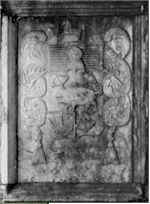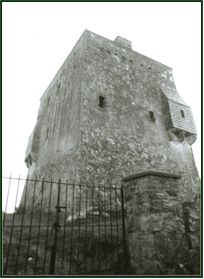| 1. Symposia / Historical Safaris
3. Research 4. Surveys
7. Folklore 9. Contact us 11. Links |
HistoryEarly and Medieval Period
This area of west Mayo, comprising the baronies of Murrisk, (including the islands of Clare, Inishturk, Caher, Inishbofin, Inishark and the smaller islands in Clew Bay) and Burrishoole (which includes Achill) is not mentioned until the twelfth century; save for an obscure mention of a lake in Umaile in Connaught which in 848 suddenly "ran off into the sea"; and that a thunderbolt fell on Cruachan Aigle (mountain of the Eagle: Croagh Patrick) on the night of the festival of Patrick, and thirty of the fasting people perished in 1113. And when there is finally 'official' mention of this region it is conjunction with the clan O' Maille (O'Malley) which according to the ancient genealogies, was descended from the eldest son of the High King of Ireland, Brian Orbsen, King of Connaught who was killed at the Battle of Dam Chluain, near Tuam, circa A.D. 388. The region comprising the two baronies of Murrisk and Burrishoole was simply referred to as the Umhalls (umall, territory), latinised as Umallia and later anglicised as the Owels. The first specific mention of Clare Island is in connection to its abbey, named in a number of sources as first a Carmelite cell dedicated to the Blessed Virgin, but soon to become attached the Cistercian House of Knockmoy. It was said to have been built by the O'Mailles in 1224. In the Annals of Ireland, (A.D. 1235),there is an account of the killing of two brothers and their internment in Cliara . In the History section of the Clare Island Survey, (1910),Westropp gives this version of the story: "In 1235, the Four Masters and the Annalist tell how Felim (son of Cathal Crovdearg) O'Conor resolved upon taking with him to O'Donnel all the cows belonging to those who would take his advice in Conmaicnemara, and Conmaicne Cuile with the son of Manus, and Conor Roe, the son of Murtagh Muimhneach, and leaving the whole country desolate to the English... The English then sent from Dun Mugdord a numerous army against the son Roderick which plundered Ecuill and carried great spoils to Drumimni. Domhnall and Muircheartach sons of Muredach Ui Maille were slain by Domhnall son of Magnus Muircheartach Ua Chonchobhair (O'Conor) in Cliara, where they were buried, probably in the newly built monastery. The abbey was entirely restored in 1480 and it was probably then that the ceiling was painted and the elaborate tomb made in the north wall. Among the Elizabethan Inquisitions relating to the Abbey we find more than once mention of "the island of Cleary", containing a quarter of land and tithes worth 13s. 4d. per annum besides reprises. It seems that the O'Mailles looked after the monks and were responsible for the upkeep of the abbey. The stone plaque showing the O'Malley coat of arms on the wall of the Clare Island Abbey, dates from the 17th century. It reads in latin: TERRA MARIA POTENS, (powerful on land and sea). For Grace O'Malley and no doubt the other members of the powerful O'Maille clan, it was their effective sea-worthiness (part of their policy of 'maintenance by land and sea' which no doubt involved much plunder and other dubious means of acquisition as was common in the 16th century) which gained them their advantage.
Ireland, up to the time of Grace's birth in 1530, had a closely interwoven system of kinship, with the clan being the prime determinant of political and social life. Brehon law governed land tenure, the method of succession and the dispensing of law and justice. English law had little effect outside the Pale. The clan system,with no unifying power structure, resulted in much squabbling, and petty warfare was the common order of the day. The Tudor reconquest of Ireland had only begun in earnest when Henry VIII had himself confirmed 'King of Ireland' in 1541, simultaneously creating the 'Kingdom of Ireland' which was to last until 1800. He created the policy of 'Surrender and Re-grant', to win back his neglected colony. The implementation of this policy was to take many forms, employing a variety of methods under different English governors, becoming more hard-fisted and brutal after Henry's death in 1547, and even more so when when Elizabeth assumed the throne in 1558. Grace O'Malleys plight during this period was no different than other Irish personnages of local power. Her father, Dubdhara O'Malley was the chieftain of the Clan O'Malley and through her various marriages, first to Donal O'Flaherty, then to Richard Burke, she created alliances with other leading clans. She variously submitted and then retracted her submissions to the Crown, cooperating with and then thwarting Elizabeth's bureaucracy by sending out her galleys as mercenaries.Her long-term nemesis was Sir Richard Bingham who became governor of Connaught in 1584. He was too shrewd for her nimble transgressions of English law. Acknowledging her capabilities and power he made a point to oppose her at every turn. She thought she had outwitted him by appealing directly to the Crown when she made her famous voyage to Greenwich in 1594. At the age of 63, she sailed around Ireland and up the Thames, to offer her submission to the Queen in exchange for the release of her son. But at the end of the day it was Bingham who ruled Connaught and not Elizabeth,and he contrived to ignore the Queen's recommendations regarding Grace indefinitely. Poetic license is understandable in the relating of this meeting of these two formidable women: Grace is said to have arrived barefoot, proclaiming her equal status to that of the Queen of England. Tradition states that Elizabeth was forced to raise her hand high as Grace was the taller of the two women and possibly the more regal in attitude. The meeting is fully documented in the State papers, the conversation having been conducted in Latin, as Grace did not speak English, having only Irish and Spanish. .
The Clare Island castle was one of some eleven castles or fortresses in theO'Malley territories. She probably used it mostly as a summer home, Rockfleet being her main residence. With Clare Island, Grace controlled the whole of Clew Bay.After her first husband, Donal O'Flaherty died, and returning to her father's territory, she gathered together a band of men, numbering over 200 and a fleet of three galley ships with which she patrolled Clew Bay, pirating lucrative cargo, levying tolls in return to safe passage through her domain and providing a pilot service for foreign vessels on their way north. Her ways and means seemed more than adequatef or those under her rule and we can only imagine a fairly content island community, variously benefitting from the spoils of their chieftainess. It is probable that her fleet was more occupied with peaceful trading missions, sailing regularly to Munster, Ulster, Scotland, Spain and Portugal to sell the produce of Connemara, and that the amount of piracy attributed to her is exaggerated for the sake of the legend. We can only imagine her common-place island table laden with food and drink that even today would be considered exotic. Grace O'Malley died in 1603 and is reputed to be buried in the abbey on Clare Island. The O'Malley clan was to rule the island until the 17th century, after which the next violent and turbulent series of events of Irish history was to sweep over the island. |
 It is through Granuaile, or Grace O'Malley that most people are aware of Clare
Island. The castle at the harbour was her summer residence. She is reputed to be
buried in the Abbey. Ann Chambers' Granuaile: The Life and Times of
grace O'Malley c. 1530-1603 (Wolfhound Press, 1994) is the most
comprehensive study of the woman. Her story is an epic one, lending itself to a maze of
embellishments and variations, many of which are historically inaccurate. Chambers' work
gets behind the legend and folklore and tries to flesh out the real, historical person.
What follows on this page is taken from our Clare Island Series booklets,
soon to be republished.
It is through Granuaile, or Grace O'Malley that most people are aware of Clare
Island. The castle at the harbour was her summer residence. She is reputed to be
buried in the Abbey. Ann Chambers' Granuaile: The Life and Times of
grace O'Malley c. 1530-1603 (Wolfhound Press, 1994) is the most
comprehensive study of the woman. Her story is an epic one, lending itself to a maze of
embellishments and variations, many of which are historically inaccurate. Chambers' work
gets behind the legend and folklore and tries to flesh out the real, historical person.
What follows on this page is taken from our Clare Island Series booklets,
soon to be republished.